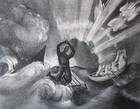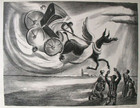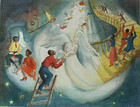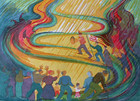Ruth Starr Rose
(1887-1965)
Ruth Starr Rose was born to a life of privilege. The daughter of a wealthy lumberman from the Midwest, she graduated from the Cathedral School and Vassar College in New York and lived most of her life at Hope House, a historic 18th century plantation her father had bought and restored in Talbot County on the Eastern Shore of Maryland. A keen sportswoman who loved horseback riding and sailing in the Chesapeake Bay, Rose was also drawn to art-making. During the winter months, she stayed in New York City to study at the Art Students League and learned lithography from master printmaker George Miller.
Rose may have known all about gracious living, but she was an artist with a social conscience, active in the United Methodist Church. She chronicled life in the poorer African-American communities of Maryland's Eastern Shore, which were a source of cheap labor for the local fishing industry. Her studies of women picking crabs recall the Ashcan school of art she had come to know as a student in Manhattan and give eloquent witness to her concern over racial discrimination.
The artist wanted to go beyond social realism to probe something deeper in the African-American experience. “I believe it was religion that brought Black Americans through their suffering,” said Rose. “If I could only convey to white people this sense that the power of God is really present here for us, people of all colors, then I’ll feel my mission is accomplished.”
Rose found the key in music. She had heard all the great African-American spirituals, sung by traveling minstrels, who had put on shows in the kitchens of Eastern Shore estates. The artist mined this rich lode of black musical folklore and imagery to create storybook-style prints of compelling simplicity, illustrating some of the most popular spirituals.
There are five examples of Rose's illustrated Spirituals in my collection: four lithographs, Didn't My Lord Deliver Daniel, It’s me, O Lord, Standing in the Need of Prayer, O, Dem Golden Slippers, and Swing Low, Sweet Chariot; and a later serigraph, When the Saints Go Marching In. Rose tries to capture the apocalyptic fervor of black spirituality and hopes for the coming Day of Jubilee in two other graphic works: the lithograph, Hear the Wondrous Word of the Lord, and the color screen print, Right in the Palm of God’s Hands.
Viewed with modern eyes, some of Rose's imagery from the 1940s may appear to foster racial stereotypes, but it needs to be viewed in historic context with other white interpretations of the black experience from about the same period: Dramatist Marc Connelly's play and film, The Green Pastures (1930/1936) and Porgy and Bess (1935), the operatic collaboration between Novelist DuBose Heyward and the Gershwin Brothers. In its time, this was progressive art, crossing racial boundary lines.

Didn’t My Lord Deliver Daniel (1942)

It’s Me, O Lord, Standing in the Need of Prayer (c. 1942)

Swing Low, Sweet Chariot (c.1945)

Right in the Palm of God’s Hand

O, Dem Golden Slippers (c. 1947)

When the Saints Go Marching In (c. 1963)

Hear the Wondrous Word of the Lord (1942)

